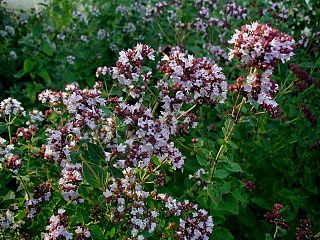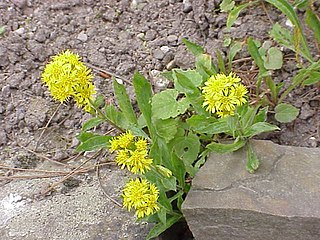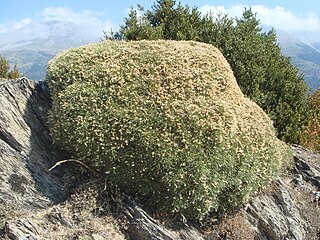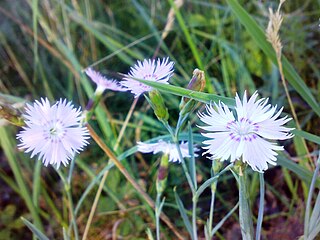
Dianthus is a genus of about 300 species of flowering plants in the family Caryophyllaceae, native mainly to Europe and Asia, with a few species in north Africa and in southern Africa, and one species in arctic North America. Common names include carnation, pink and sweet william.

Cota tinctoria, the golden marguerite, yellow chamomile, or oxeye chamomile, is a species of perennial flowering plant in the sunflower family. Other common names include dyer's chamomile, Boston daisy, and Paris daisy. In horticulture this plant is still widely referred to by its synonym Anthemis tinctoria.

Primula vulgaris, the common primrose, is a species of flowering plant in the family Primulaceae, native to western and southern Europe, northwest Africa, and parts of southwest Asia. The common name is primrose, or occasionally common primrose or English primrose to distinguish it from other Primula species also called primroses. None of these are closely related to the evening primroses.

Origanum is a genus of herbaceous perennials and subshrubs in the family Lamiaceae, native to Europe, North Africa, and much of temperate Asia, where they are found in open or mountainous habitats. A few species also naturalized in scattered locations in North America and other regions.

Solidago virgaurea, the European goldenrod or woundwort, is an herbaceous perennial plant of the family Asteraceae. It is widespread across most of Europe as well as North Africa and northern, central, and southwestern Asia. It is grown as a garden flower with many different cultivars. It flowers profusely in late summer.

Dianthus superbus, the fringed pink or large pink, is a species of Dianthus native to Europe and northern Asia, from northernmost Spain and France north to arctic Norway, and east to Japan; in the south of its range, it occurs at high altitudes, up to 2,400 m.

Echinospartum is a genus of flowering plants in the legume family, Fabaceae. It belongs to the subfamily Faboideae. It is possibly synonymous with Genista.

Coincya monensis is a plant species in the family Brassicaceae. Coincya monensis is native to western Europe and Morocco, but has been introduced in North America.
Nasturtium africanum, the Moroccan watercress, is an aquatic plant endemic to Morocco. Two subspecies are recognized:

Tulipa sylvestris, the wild tulip or woodland tulip, is a Eurasian and North African species of wild tulip, a plant in the lily family. Its native range extends from Portugal and Morocco to western China, covering most of the Mediterranean and Black Sea Basins, and Central Asia. The species is also cultivated as an ornamental and naturalized in central and northern Europe as well as a few scattered locations in North America. It was first recorded as being naturalised in Britain in the late 17th century.

Petrorhagia saxifraga, known as tunic flower or coat flower, is a small, herbaceous flowering plant in the family Caryophyllaceae. It is native to parts of Europe and introduced to the United States and Canada, Great Britain, and Sweden. Petrorhagia saxifraga is also known as tunic saxifrage, pink saxifrage, or just pink.

Dianthus arenarius, the sand pink, is a species of Dianthus typically found on the shores of the Baltic Sea, although there are populations elsewhere in colder areas of Europe where there are sandy soils. The unimproved species, and at least one cultivar, 'Little Maiden', are available from commercial suppliers.
Dianthus orientalis, called the Georgian pink, is a species of pink in the carnation family found in the Levant, Anatolia, the Transcaucasus and the North Caucasus, Iraq and Iran, and disjunctly in Tibet and Xinjiang in China. Given its preference for drier, rocky and alkaline soils, and its attractive lilac‑pink flowers which appear in autumn, it is being studied as a potential ornamental plant, and for use on green roofs.

Dianthus crinitus is a species of Dianthus in the carnation family found in northwestern Africa, the eastern Aegean Islands, Anatolia, the Transcaucasus and the North Caucasus, Lebanon, Syria, Iran, the Gulf States, and Oman. Common names may be associated more with some subspecies than others, and include hairy carnation and long‑haired pink. It grows on serpentine soils.

Dianthus giganteus, the giant pink, is a species of pink native to Romania, the Balkan peninsula, and possibly nearby areas. A perennial with flowerheads reaching 1 m, it is useful in gardening and landscaping applications where a backdrop of taller plants is needed. It is available from commercial suppliers, with the Royal Horticultural Society considering it to be a good plant to attract pollinators.

Dianthus petraeus, the rock pink or fragrant snowflake garden pink, is a species of Dianthus native to Romania, the former Yugoslavia, Albania, and Bulgaria. It is often found growing on calcareous rocky slopes, or in dry highland forest edges. Is is occasionally grown in rock gardens.

Dianthus myrtinervius, the Albanian pink, is a species of pink native to Albania, Greece, and the former Yugoslavia. Preferring well-drained neutral to alkaline soils, it can be grown in rock gardens, raised beds, or as a border along gravel paths. Petite perennials, they are available from commercial suppliers.

Digitalis mariana is a flowering plant species in the family Plantaginaceae. It is a perennial foxglove with evergreen foliage and rose-red coloured flowers produced in summer. It is native to Portugal and Spain.

Genista sagittalis, called the arrow-jointed broom and winged broom, is a species of flowering plant in the genus Genista, native to central and southern Europe, Ukraine, and Anatolia. Its subspecies Genista sagittalis subsp. delphinensis, called rock broom, has gained the Royal Horticultural Society's Award of Garden Merit.

















